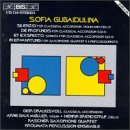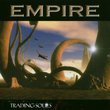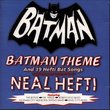| All Artists: Sofia Gubaidulina, Kroumata Percussion Ensemble, Rascher Saxophone Quartet Title: Gubaidulina: Silenzio/De profundis/Et exspecto/In Erwartung Members Wishing: 2 Total Copies: 0 Label: Bis Release Date: 3/28/1995 Album Type: Import Genre: Classical Styles: Chamber Music, Historical Periods, Classical (c.1770-1830) Number of Discs: 1 SwapaCD Credits: 1 UPCs: 789368144723, 731859007105 |
Search - Sofia Gubaidulina, Kroumata Percussion Ensemble, Rascher Saxophone Quartet :: Gubaidulina: Silenzio/De profundis/Et exspecto/In Erwartung
 | Sofia Gubaidulina, Kroumata Percussion Ensemble, Rascher Saxophone Quartet Gubaidulina: Silenzio/De profundis/Et exspecto/In Erwartung Genre: Classical
|
Larger Image |
CD DetailsSimilar CDs
|
CD ReviewsGood intro to Gubaidulina's unusual instrumentation and tech Christopher Culver | 08/16/2005 (4 out of 5 stars) "This BIS disc contains four works by deeply religious Russian-Tatar composer Sofia Gubaidulina which all make use of unusual instrumention. The first three use the accordion, played by Geir Draugsvoll, while the last is for percussion and saxaphone, performed by the Rascher Saxophone Quartet and Kroumata Percussion Ensemble. The amount of creative thinking and technical innovation present in the pieces here places them in a rare class of contemporary works, and I found them very enjoyable.
Gubaidulina has written more extensively for the accordion (mostly for the Russian variant called the bayan) than any other composer, attracted by the living properties of an instrument that "breathes". Her latest work for the instrument is her "Under the Sign of Scorpio" concerto for bayan and large orchestra (2003), dedicated to Friedrich Lips. The earlier accordion works here, however, are for much smaller ensemble, the first being for a trio of instruments and the latter two for accordion solo. "Silenzio" (1991) is a set of five pieces for bayan, violin, and cello and was dedicated to Elsbeth Moser. As one can imagine from the title, this is a piece of very restrained scoring. For Gubaidulina, silence is evocative of God and the religious experience, and is found often in her work (see its greatest exposition in the "conductor's solo" of her symphony "Stimmen ...Verstummen", the second string quartet is an example as well). The most active piece is the fourth, where pizzicato playing on the strings manages to overwhelm the accordion, which plays short tremolo bursts under the surface. Arne Balk Moller performs here on violin and Henrik Brendstrup on cello. "De profundis" for solo bayan (1978) was Gubaidulina's first piece for the instrument and was dedicated to Friedrich Lips, who nearly thirty years later continues to champion her music. Again the piece seems to represent Man in communication with God, but in contrast to the earlier "Silenzio", the emphasis here is on the human side of prayer. "Out of the depths I have cried..." says the psalmist, and here the accordion is constantly active, with writing so frenetic and challenge that the instrument approximates an organ. The "Et exspecto" sonata for solo bayan (1987) was yet another piece dedicated to Lips. In spite of its religious title, it has no clear programme. This piece is the most technically demanding of the three accordion pieces here, and most explores the breathing qualities of the instrument which fascinate Gubaidulina. However, as an "average listener", I find it to be the least enjoyable of the three. Gubaidulina is also noted for two other innovations. One is giving percussion a solo role in many of her works, instead of letting it remain in the background as in traditional writing. Another is approximating one sort of instrument to another, as when in "Music for Flute, Strings, and Percussion", the string players breathe through their instruments, producing eerie sounds, to emulate the flautist. "In Erwartung" for six percussionists and saxophone quartet (1994) combines this two qualities. In its first section, the saxophones approach the percussion by playing short, sharp sounds. A middle section shows the two classes of instruments in normal contrast. Finally, the percussionists use various techniques to produce sustained sounds that blend with the sonorities of the saxophones. Performances are excellent. Draugsvoll's accordion playing is as strong as anything by Moser or Lips, and the percussionists are commendable. The liner notes, with essay by Valentina Kholopova, is informative. I think Gubaidulina's most exciting work is that for large orchestral forces--I can't recommend enough her great symphony "Stimmen ...Verstummen" or her masterpiece "Johannes-Passion". However, the accordion works here are at the core of her oeuvre, and well-worth hearing. If you enjoy these, you should also pick up the aforementioned Naxos disc, which contains also her stunning and heartbreaking "Seven Words" for cello, bayan, and strings and the arrangement "In Croce" for bayan and cello." |

 Track Listings (12) - Disc #1
Track Listings (12) - Disc #1

